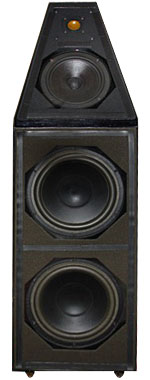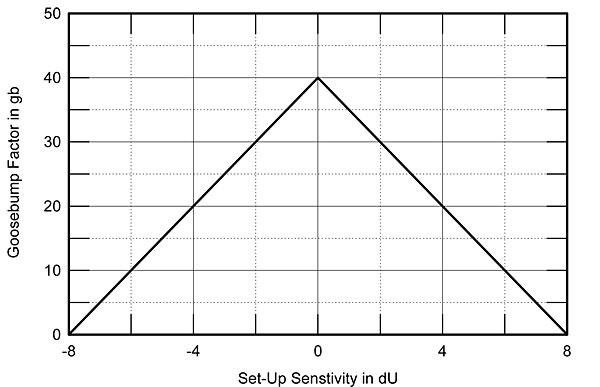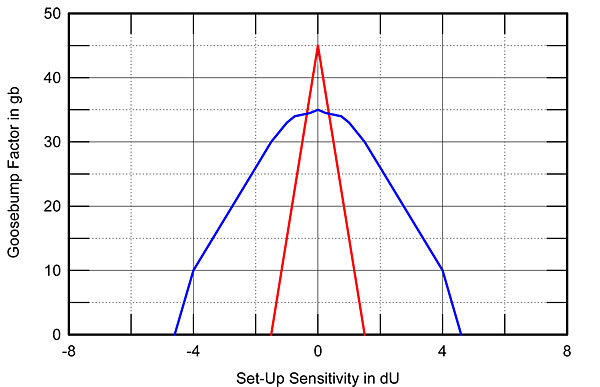| Columns Retired Columns & Blogs |
Wilson WATT Series 3-Puppy 2 loudspeaker
 "No pain; no gain." Thus goes the June 1991 offering from the Cliché-of-the-Month Club—(800) MOT-JUST—a saying that seems particularly appropriate for audiophiles with aspirations. High-performance loudspeakers fall into two categories. First are those exasperating thoroughbreds requiring endless Tender Loving Care and fussy attention to system detail to work at all. Take the Avalon Eclipse or the Infinity IRS Beta, for example: when everything is just fine, you put on record after record, trying to get through as much music as possible before the system goes off song again. On the other hand, speakers like the Vandersteens, Magnepans, B&W 801 Matrix, and KEF R107/2 appear to sound excellent even as you unpack them, before you've even put them in what you think might be the optimum positions in your listening room.
"No pain; no gain." Thus goes the June 1991 offering from the Cliché-of-the-Month Club—(800) MOT-JUST—a saying that seems particularly appropriate for audiophiles with aspirations. High-performance loudspeakers fall into two categories. First are those exasperating thoroughbreds requiring endless Tender Loving Care and fussy attention to system detail to work at all. Take the Avalon Eclipse or the Infinity IRS Beta, for example: when everything is just fine, you put on record after record, trying to get through as much music as possible before the system goes off song again. On the other hand, speakers like the Vandersteens, Magnepans, B&W 801 Matrix, and KEF R107/2 appear to sound excellent even as you unpack them, before you've even put them in what you think might be the optimum positions in your listening room.
The question is: Are such unfussy designs really high-end? I mean, if they were truly high-performance speakers, shouldn't the owner have to suffer even just a little to reach musical nirvana? "A little pain; some sonic gain!" goes that other familiar saying.
You all know where you stand on this vitally important question. Me, I prefer to sit and construct the following graphical analogy. Draw a vertical axis and mark it "Absolute Performance." (The units are "gb," footnote 1) Now draw a horizontal axis and label it "Setup." (The units are "dU" for "deci-Ungers," footnote 2) Okay, sketch out an inverted V-shape. This curve, something like an engine's torque vs RPM curve, represents the manner in which a system's or component's performance changes according to how it is set up.
You should now have a graph which looks like my fig.1. If the apex of the inverted V represents the maximum sonic performance of which the system is capable, you can see that moving in either direction along the setup axis results in a less satisfying sound. Arbitrarily replace one component with a more expensive one: unless you've started from a position deficient in deci-Ungers, the result is a global reduction in gb. Be particularly sloppy in how you set your system up: you can immediately see from fig.1 that the sound quality will suffer accordingly.

Fig.1, Typical loudspeaker set-up senstivity, in gb per dU.
Now look at fig.2, which shows the characteristic curves for two high-end loudspeakers, A and B. (Rather than measure the gb/dU curves, I used the manufacturers' data. I don't see that it makes a difference for illustration purposes.) Though A is capable of an extraordinarily high gb performance, its extremely sharp curve shows that even a change of a mU in setup will knock it significantly off-song. In fact, it's probably unlikely that A's owner will ever achieve its maximum gb. However, while B's performance curve doesn't quite reach the pinnacle represented by A, note that even quite large changes in setup have only a small effect in gb. Note also that for quite a large range of dU, loudspeaker B actually gives a higher gb than loudspeaker A, despite its theoretically lower absolute performance limit.

Fig.2 Set-up sensitivity, in gb per dU, for loudspeakers A (top trace at 0dU) and B.
Mathematically inclined readers will have already appreciated the fact that the fundamental difference in character between loudspeakers A and B can be described as a single quotient, proportional to the "sharpness" of the gb/dU curve. If you take the inverse of the difference in dU between the –6gb points on this curve, you get a dimensionless quantity which I shall call "Q," for "Quality Factor." While loudspeaker A has a high Q, loudspeaker B has a low Q, meaning that B is much less fussy when it come to setup. I hope that one day it will become common practice for high-end manufacturers to state their components' subjective performance Q-factors in the specifications. Life would then become a lot easier for audiophiles. In the meantime, you have to rely on the dedicated efforts of reviewers like myself to determine such necessary data. (I welcome your input on the Q ratings for the components listed in Stereophile's semiannual "Recommended Components.")
Which brings me to Wilson Audio Specialties' WATT/Puppy combination.
What?
I doubt there is an audiophile in the world unfamiliar with the Wilson Audio Tiny Tot (WATT). Introduced at the 1986 Winter CES, this diminutive two-way immediately attracted attention for the superb quality of its construction, the tangibility and accuracy of its soundstaging, and the lightweight nature of its bass when positioned on stands away from room boundaries. This was to be expected, however, given that David Wilson, of $88,000 Wilson Audio Modular Monitor (WAMM) fame, had wanted to develop a small nearfield monitor for location recording, the bass output of which would normally be augmented by the close proximity of a boundary in the shape of the mixing console. Nevertheless, the WATT—which couples a much-modified Focal T-120 inverted-dome tweeter with a doped-pulp–cone woofer from the Norwegian SEAS company in a cast mineral-loaded, methacrylate-resin enclosure with optional wooden side panels—rapidly developed an audiophile profile.
In his 1988 Stereophile review (footnote 3), Martin Colloms mentioned the WATT's superb resolution of detail, transparency, focus, and depth as being revelatory, coupled with a build quality which he instanced as being "the most perfect exposition of cabinet construction." However, he had to weigh this performance against the speaker's lightweight bass, erratic response in the vertical plane, and awkward impedance, which dropped to a very low value in the lower treble, necessary to control a dustcap resonance in the woofer.
Wilson's development of the "Gibraltar" stand, which in effect extended the front baffle area downward to the floor, helped the speaker extend its bass response, while many users coupled the WATT with subwoofers, the Entec SW-5 in particular, to give a full-range system that preserved the speaker's remarkable qualities. (Wilson recommended that the WATT still be used on its Gibraltar stand rather than sitting on the Entec.) In 1989, at serial number 515, I believe, the Series 2 WATT followed, with a smoother midrange balance, a more extended, less overdamped bass, a slightly higher overall sensitivity, and a less cruel impedance. Then, in the summer of 1990, David Wilson launched the Puppy, not so much an independent subwoofer as a dedicated woofer to turn the WATT into a full-range three-way system. (This time, the WATT does sit on the woofer.)
When I interviewed David Wilson in 1990 (footnote 4), I asked him to give me a thumbnail characterization of the Puppy's design goal: "The Puppy is designed to take what was originally intended to be a highly compact, location reference speaker and convert it into a three-way system which can be put into a domestic or professional environment...It is intended to extend the low-frequency response of the WATT, expand its dynamic capabilities, flesh out in a highly coherent way the lower midrange, the 'warmth' region, and to actually improve the linearity of the overall system."
And how low would the Puppy go? "We knew [the Puppy] would be that size because the WATT likes to be at a certain height for most listening environments, and you don't want the woofer to be grossly wider than the WATT, you don't want it to be grossly deeper...To get 20Hz out of a system that size, you'd probably end up using a single, small, very-high-compliance woofer with a fairly massive cone, a fairly small magnet, and what you would get would be a measured 20Hz output at low levels. It would be sluggish, inefficient, and wouldn't have good power-handling capacity; its dynamic characteristics would not at all match those of the WATT.
"I consider that too high a price to pay for 20Hz. So...how low do you have to go for most listening? For a sensitive listener to achieve musical satisfaction out of a wide range of music, the consensus was that if you could achieve 40Hz with absolute authority, then that probably would be enough. So in my mind, I established 40Hz as an acceptable low-frequency extension...The Puppy has its –3dB point, measured at the port, of around 30Hz. 35Hz is no problem with it. 32Hz is quite reachable in most rooms. We don't get the 20, we don't get 24, but we get a real nice 30—more than we had originally bargained for—and the overall performance envelope is broader than we had expected."
Footnote 1: For "goosebumps." I had wanted to use the American unit of musical performance, the "Gordon," on the grounds that it was Stereophile's J. Gordon Holt who first pointed out back in the 1960s the fact that to be judged good, a component has to be capable of raising goosebumps on the listener's arm. But as Richard Lehnert pointed out that the "gb" is the accepted international standard unit, I'll stick with it for the purposes of this essay.
Footnote 2: 10dU = 1 Unger, which of course represents too large an amount of setup care for everyday purposes. I'm surprised that neither the home-furnishing industry nor Consumer Reports has adopted the dU (now in widespread use in Europe), both preferring instead to rely on purely subjective measurement techniques.
Footnote 3: Vol.11 No.2, February 1988, p.88.
Footnote 4: Vol.13 No.6, June 1990, p.78.
- Log in or register to post comments

Waiting for Mr. Goodsnark
Submitted by fkrausz on October 5, 2011 - 10:04am
JA,
Great fun reading this post. Seems that you haven't let yourself be this satirical in recent years. Let me encourage you to do so whenever the muse inspires you.

Re; Waiting for Mr. Goodsnark
Submitted by John Atkinson on October 5, 2011 - 4:33pm
Great fun reading this post. Seems that you haven't let yourself be this satirical in recent years. Let me encourage you to do so whenever the muse inspires you.
This was a fun review to write, as well as being the longest review of a single product I have ever written. Can't believe it was more than 20 years ago!
John Atkinson
Editor, Stereophile




































